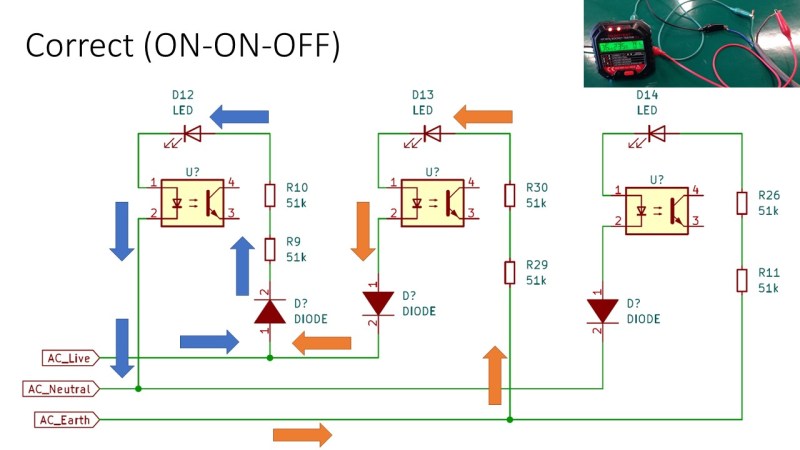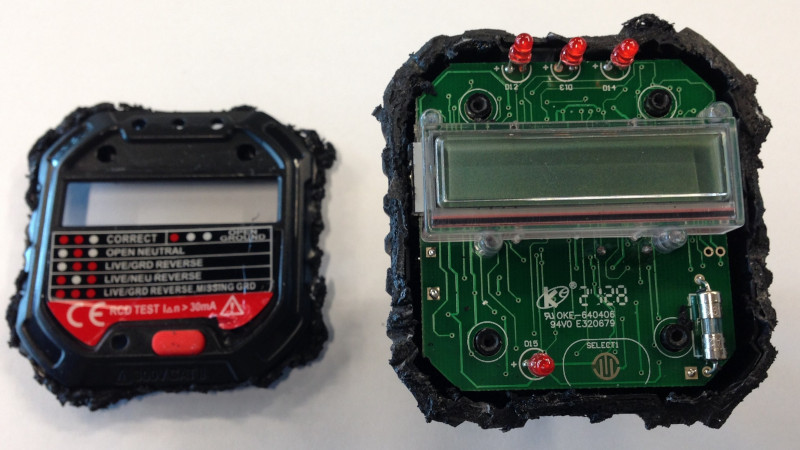The concept of an outlet tester is pretty simple: plug the gadget into a suspect wall receptacle, and an array of LEDs light up in various patterns to alert the user to any wiring faults. They’re cheap, reliable, and instantaneous. Most people wouldn’t give them much more thought than that, but like any good hacker, [Yeo Kheng Meng] wanted to know how these devices worked.
After picking up a relatively advanced model that featured an LCD display capable of showing various stats such as detected voltage in addition to the standard trio of LEDs, he started by using some test leads to simulate various fault conditions to understand the basic principle behind its operation. The next step was to disassemble the unit, which is where things went briefly sideways — it wasn’t until [Yeo Kheng Meng] and a friend had nearly cut through the enclosure that they realized it wasn’t ultrasonically welded liked they assumed, and that the screws holding it together were actually hidden under a sticker. Oops.
 The write-up includes some excellent PCB shots, and [Yeo Kheng Meng] was able to identify several components and ascertain their function. He was even able to find some datasheets, which isn’t always such an easy task with these low-cost devices. Unfortunately the MCU that controls the device’s more advanced features is locked away with a black epoxy blob, but he was able to come up with a schematic that explains the rather elegant logic behind the LED display.
The write-up includes some excellent PCB shots, and [Yeo Kheng Meng] was able to identify several components and ascertain their function. He was even able to find some datasheets, which isn’t always such an easy task with these low-cost devices. Unfortunately the MCU that controls the device’s more advanced features is locked away with a black epoxy blob, but he was able to come up with a schematic that explains the rather elegant logic behind the LED display.
This isn’t the first time [Yeo Kheng Meng] has taken apart an interesting piece of hardware for our viewing pleasure, and given the fine job he does of it, we hope it’s not the last either.















Always check under stickers, LOL. I’ve discoved that several times myself.
Yeah, I assume pretty much every HaD reader knows that or a principally similar story… ;-)
Plus if you insert a shim, you can make out if it’s welded or not.
Anyway, cracking open in vise is aways preferred than cutting through for the later.
yes cutting leaves a gap.
applying a pressure with a vice usually results in a reasonable clean crack along the weld
if you use a round edge like the edge of a coin you can stretch the sticker over the hole, leaving a small detent. then you can punch through with a screwdriver.
Strong magnets are good at finding screws hidden under stickers.
Two tools I wish I had sooner are the razor saw and the utility cutter that has pliers handles and a razor blade that works into a composite flat surface. I use it to cut up so many things. Much safer than the old way with a knife.
I also don’t know what to call those “utility cutter with plier handles”. They’re excellent for neatly trimming coax cables, and can cut through pretty much anything that can be cut with side cutters. 10mm^2 copper cables? No problem. And having a replaceable blade means they never go dull.
Just post a product name or search term…
I use sheep hoof trimmers for that kind of work.
Other hiding place: if the device has rubber “feet”, you can bet there will be screws under them.
Best regards,
A/P Daniel F. Larrosa
Montevideo – Uruguay
I had the darnedest time trying to open up a Tuner Subber.
It had deep screw wells and I couldn’t get any screwdriver bit to work.
With enough light shining down one of screw wells, I could see they had shoved a plastic washer down each hole. A small crochet hook pulled the washers out!
(Yes, there is a small crochet hook in my tool box, it also came in handy for hooking springs into position in tape decks.)
Or you can make your own little tester using three NE-2 neon bulbs instead of LEDs and diodes.
https://diy.stackexchange.com/questions/113033/what-to-do-with-a-new-duplex-outlet-when-the-tester-says-hot-ground-are-revers/113052#113052